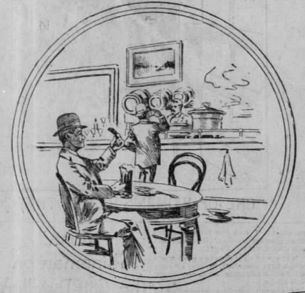As I mentioned Monday, Andreas Krennmair has posted a recipe for a turn-of-the-century steam beer, warning readers, “This recipe does not conform to the BJCP Style Guidelines for the California Common beer style, so don’t use this to brew beer and get bad marks for it at home-brewing competitions.”
How similar would it have tasted to a steam beer in the 1890s or one shortly after the beginning of the 20th century?
 First off, we don’t have much in the way of tasting notes. There was his from July of 1896, by a journalist assigned to write about being “A Prince for a Day in San Francisco on Two Bits” in The San Francisco Call. He put a glass of steam beer, which along with a choice of dishes and bread cost a nickel, at the center of his first meal.
First off, we don’t have much in the way of tasting notes. There was his from July of 1896, by a journalist assigned to write about being “A Prince for a Day in San Francisco on Two Bits” in The San Francisco Call. He put a glass of steam beer, which along with a choice of dishes and bread cost a nickel, at the center of his first meal.
“Upon the surface of amber-colored beer floated foam as evanescent and light as thistle down,” he wrote, without naming the brewery where it was made. “The receptacle holding the beer was as deep and as musical, as it was clinked against another, as a bell of Shandon ‘That sound so grand on the River Lee.’ Clearly through its translucent sides could be observed sparkling effervescence, the riotous ascent of sparkling globules which conferred, as a reward for patronage of a plebian beverage, a delightful tang, in which was all the lusty flavor of sun-kissed fields of bearded barley, waving and rustling in the wind.”
Second, every ingredient is a wild card, but yeast is the wildest of all. Presumably, yeast used to brew steam beer evolved from a lager strain. However, in 1911, while conducting tests as part of another project at the University of California, T. Brailsford Robinson discovered just how different steam beer yeast acquired from California Brewing in San Francisco was from lager strains.
“The yeast of the steam beer has accommodated itself to these conditions (warmer fermentation and the clarifier) to such an extent that it can no longer be employed for the preparation of lager beer, while lager-beer yeast may without difficulty be used for the manufacture of steam beer,” he wrote. “The cells of the typical steam-beer yeast are somewhat smaller than those of lager-beer yeast.”
Because things happen, like Prohibition, the strains that brewers used then were not passed down.
Fun aside
Over the years, there have been several suggestions about why steam beer was called by that name:
– What looked, and sounded, like steam was generated by the pressure generated in the kegs.
– Steam hung above rooftop vessels that initially cooled the beer.
– “Doctor Steam” (whose first name has been given variously as Frank, Heintz, or Charles) invented the process.
– German brewers would have been familiar with Dampfbier (“steam beer” in German), itself a hybrid.
– The first brewer to make it, according to his son, named it “mission steam beer, after the (California) missions.” (f
Or steam was just a ubiquitous 1800s adjective conveying a sense of modern tech: http://abetterbeerblog427.com/2017/08/04/when-steam-was-king-it-was-common/
Yes, you read through “100 Years of Brewing” you’ll will find plenty of instances where steam means steam powered. However, steam beer came to have a specific meaning on the West Coast. California Common, on the other hand, had no meaning.
Could be. Not sure you can separate the two so neatly at the point it was originally used given the wider general linguisitic usage.
Addendum: consider if the doctor indicated that he was going to give you a “digital” examination. In recent years at least you have a hope!